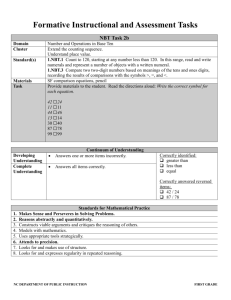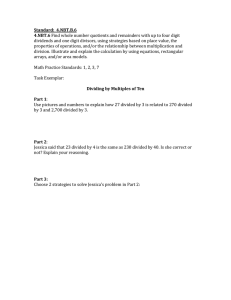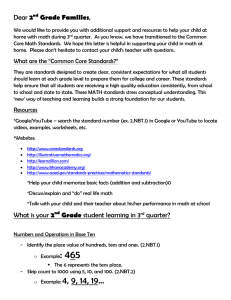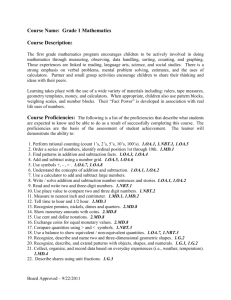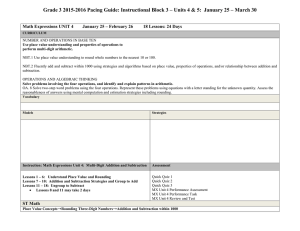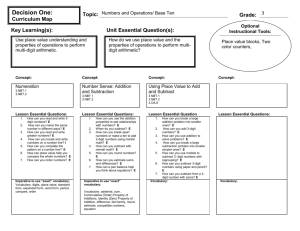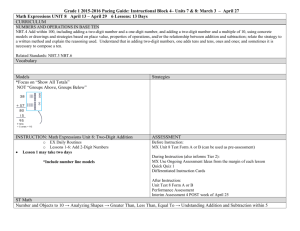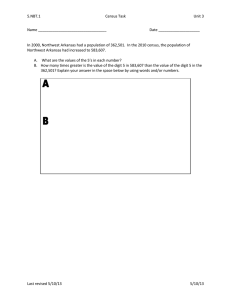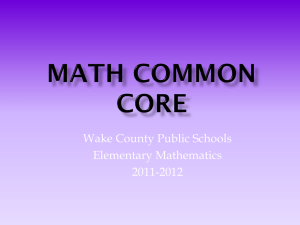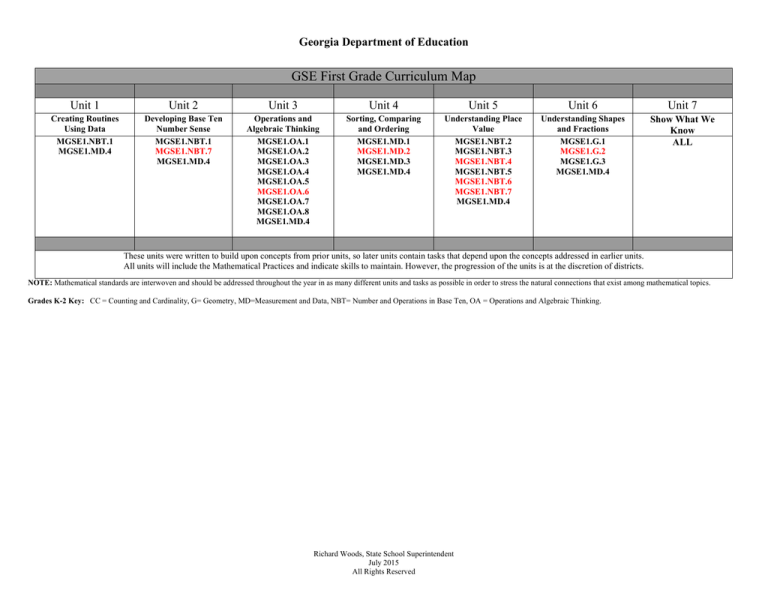
Georgia Department of Education
GSE First Grade Curriculum Map
Unit 1
Unit 2
Unit 3
Unit 4
Unit 5
Unit 6
Unit 7
Creating Routines
Using Data
MGSE1.NBT.1
MGSE1.MD.4
Developing Base Ten
Number Sense
MGSE1.NBT.1
MGSE1.NBT.7
MGSE1.MD.4
Operations and
Algebraic Thinking
MGSE1.OA.1
MGSE1.OA.2
MGSE1.OA.3
MGSE1.OA.4
MGSE1.OA.5
MGSE1.OA.6
MGSE1.OA.7
MGSE1.OA.8
MGSE1.MD.4
Sorting, Comparing
and Ordering
MGSE1.MD.1
MGSE1.MD.2
MGSE1.MD.3
MGSE1.MD.4
Understanding Place
Value
MGSE1.NBT.2
MGSE1.NBT.3
MGSE1.NBT.4
MGSE1.NBT.5
MGSE1.NBT.6
MGSE1.NBT.7
MGSE1.MD.4
Understanding Shapes
and Fractions
MGSE1.G.1
MGSE1.G.2
MGSE1.G.3
MGSE1.MD.4
Show What We
Know
ALL
These units were written to build upon concepts from prior units, so later units contain tasks that depend upon the concepts addressed in earlier units.
All units will include the Mathematical Practices and indicate skills to maintain. However, the progression of the units is at the discretion of districts.
NOTE: Mathematical standards are interwoven and should be addressed throughout the year in as many different units and tasks as possible in order to stress the natural connections that exist among mathematical topics.
Grades K-2 Key: CC = Counting and Cardinality, G= Geometry, MD=Measurement and Data, NBT= Number and Operations in Base Ten, OA = Operations and Algebraic Thinking.
Richard Woods, State School Superintendent
July 2015
All Rights Reserved
Georgia Department of Education
GSE First Grade
GSE First Grade Expanded Curriculum Map
1 Make sense of problems and persevere in solving them.
2 Reason abstractly and quantitatively.
3 Construct viable arguments and critique the reasoning of others.
4 Model with mathematics.
Unit 1
Creating Routines Using Data
Extend the counting sequence.
MGSE1.NBT.1 Count to 120, starting at any
number less than 120. In this range, read and
write numerals and represent a number of
objects with a written numeral.
Represent and interpret data.
MGSE1.MD.4 Organize, represent, and
interpret data with up to three categories; ask
and answer questions about the total number
of data points, how many in each category,
and how many more or less are in one
category than in another.
1
2
Standards for Mathematical Practice
5 Use appropriate tools strategically.
6 Attend to precision.
7 Look for and make use of structure.
8 Look for and express regularity in repeated reasoning.
Unit 2
Developing Base Ten Number Sense
Unit 3
Operations and Algebraic Thinking
Unit 4
Sorting, Comparing and Ordering
Extend the counting sequence.
MGSE1.NBT.1 Count to 120, starting at any
number less than 120. In this range, read and
write numerals and represent a number of
objects with a written numeral.
MGSE1.NBT.7 Identify dimes, and
understand ten pennies can be thought of as
a dime. (Use dimes as manipulatives in
multiple mathematical contexts.)
Represent and interpret data.
MGSE1.MD.4 Organize, represent, and
interpret data with up to three categories; ask
and answer questions about the total number
of data points, how many in each category,
and how many more or less are in one
category than in another.
Represent and solve problems involving
addition and subtraction.
MGSE1.OA.1 Use addition and subtraction
within 20 to solve word problems involving
situations of adding to, taking from, putting
together, taking apart, and comparing, with
unknowns in all positions, e.g., by using
objects, drawings, and equations with a
symbol for the unknown number to represent
the problem. 1
MGSE1.OA.2 Solve word problems that call
for addition of three whole numbers whose
sum is less than or equal to 20, e.g., by using
objects, drawings, and equations with a
symbol for the unknown number to represent
the problem.
Understand and apply properties of
operations and the relationship between
addition and subtraction.
MGSE1.OA.3 Apply properties of operations
as strategies to add and subtract. 2
Examples: If 8 + 3 = 11 is known, then 3 + 8 =
11 is also known. (Commutative property of
addition.) To add 2 + 6 + 4, the second two
numbers can be added to make a ten, so 2 + 6
+ 4 = 2 + 10 = 12. (Associative property of
addition.)
MGSE1.OA.4 Understand subtraction as an
unknown-addend problem. For example,
subtract 10 – 8 by finding the number that
makes 10 when added to 8.
Measure lengths indirectly and by iterating
length units.
MGSE1.MD.1 Order three objects by length;
compare the lengths of two objects indirectly
by using a third object.
MGSE1.MD.2 Express the length of an
object as a whole number of length units,
by laying multiple copies of a shorter object
(the length unit) end to end; understand
that the length measurement of an object is
the number of same-size length units that
span it with no gaps or overlaps. (Iteration)
Tell and write time.
MGSE1.MD.3 Tell and write time in hours
and half-hours using analog and digital clocks.
Represent and interpret data.
MGSE1.MD.4 Organize, represent, and
interpret data with up to three categories; ask
and answer questions about the total number
of data points, how many in each category,
and how many more or less are in one
category than in another.
See Glossary, Table 1
Students need not use formal terms for these properties. Problems should be within 20.
Richard Woods, State School Superintendent
July 2015
All Rights Reserved
Georgia Department of Education
Add and subtract within 20.
MGSE1.OA.5 Relate counting to addition
and subtraction (e.g., by counting on 2 to add
2).
MGSE1.OA.6 Add and subtract within 20.
a. Use strategies such as counting
on; making ten (e.g., 8 + 6 = 8 + 2
+ 4 = 10 + 4 = 14); decomposing a
number leading to a ten (e.g., 13 –
4 = 13 – 3 – 1 = 10 – 1 = 9); using
the relationship between addition
and subtraction (e.g., knowing
that 8 + 4 = 12, one knows 12 – 8 =
4); and creating equivalent but
easier or known sums (e.g., adding
6 + 7 by creating the known
equivalent 6 + 6 + 1 = 12 + 1 = 13).
b. Fluently add and subtract within
10.
Work with addition and subtraction
equations.
MGSE1.OA.7 Understand the meaning of the
equal sign, and determine if equations
involving addition and subtraction are true or
false. For example, which of the following
equations are true and which are false? 6 = 6,
7 = 8 – 1, 5 + 2 = 2 + 5, 4 + 1 = 5 + 2.
MGSE1.OA.8 Determine the unknown whole
number in an addition or subtraction equation
relating to three whole numbers. For example,
determine the unknown number that makes the
equation true in each of the equations 8 + ? =
11, 5 = □ – 3, 6 + 6 = ∆.
Represent and interpret data.
MGSE1.MD.4 Organize, represent, and
interpret data with up to three categories; ask
and answer questions about the total number
of data points, how many in each category,
and how many more or less are in one
category than in another.
GSE First Grade
GSE FirstRichard
Grade
Expanded Curriculum Map
Woods, State School Superintendent
July 2015
All Rights Reserved
Georgia Department of Education
Standards for Mathematical Practice
5 Use appropriate tools strategically.
6 Attend to precision.
7 Look for and make use of structure.
8 Look for and express regularity in repeated reasoning.
1 Make sense of problems and persevere in solving them.
2 Reason abstractly and quantitatively.
3 Construct viable arguments and critique the reasoning of others.
4 Model with mathematics.
3
Unit 5
Understanding Place Value
Unit 6
Understanding Shapes and Fractions
Unit 7
Show What We Know
Understand place value.
MGSE1.NBT.2.Understand that the two digits of a two-digit
number represent amounts of tens and ones. Understand the
following as special cases:
a. 10 can be thought of as a bundle of ten ones —
called a “ten.”
b. The numbers from 11 to 19 are composed of a ten
and one, two, three, four, five, six, seven, eight, or
nine ones.
c. The numbers 10, 20, 30, 40, 50, 60, 70, 80, 90 refer
to one, two, three, four, five, six, seven, eight, or nine
tens (and 0 ones).
MCC1.NBT.3 Compare two two-digit numbers based on
meanings of the tens and ones digits, recording the results of
comparisons with the symbols >, =, and <.
Use place value understanding and properties of operations
to add and subtract.
MGSE1.NBT.4 Add within 100, including adding a twodigit number and a one-digit number and adding a twodigit number and a multiple of ten (e.g., 24 + 9, 13 + 10, 27
+ 40), using concrete models or drawings and strategies
based on place value, properties of operations, and/or
relationship between addition and subtraction; relate the
strategy to a written method and explain the reasoning
used.
MGSE1.NBT.5 Given a two-digit number, mentally find 10
more or 10 less than the number, without having to count;
explain the reasoning used.
MGSE1.NBT.6 Subtract multiples of 10 in the range 10-90
from multiples of 10 in the range of 10-90 (positive or zero
differences), using concrete models or drawings and
strategies based on place value, properties of operations
and/or the relationship between addition and subtraction;
relate the strategy to a written method and explain the
reasoning used. (e.g.,70 – 30, 30 – 10, 60 – 60)
MGSE1.NBT.7 Identify dimes, and understand ten pennies
can be thought of as a dime. (Use dimes as manipulatives in
Reason with shapes and their attributes.
MGSE1.G.1 Distinguish between defining attributes (e.g.,
triangles are closed and three-sided) versus non-defining
attributes (e.g., color, orientation, overall size); build and draw
shapes to possess defining attributes.
MGSE1.G.2 Compose two-dimensional shapes (rectangles,
squares, trapezoids, triangles, half-circles, and quartercircles) or three-dimensional shapes (cubes, right
rectangular prisms, right circular cones, and right circular
cylinders) to create a composite shape, and compose new
shapes from the composite shape. 3 This is important for the
future development of spatial relations which later connects
to developing understanding of area, volume, and fractions. 4
MGSE1.G.3 Partition circles and rectangles into two and four
equal shares, describe the shares using the words halves,
fourths, and quarters, and use the phrases half of, fourth of, and
quarter of. Describe the whole as two of, or four of the shares.
Understand for these examples that decomposing into more
equal shares creates smaller shares.
Represent and interpret data.
MGSE1.MD.4 Organize, represent, and interpret data with up
to three categories; ask and answer questions about the total
number of data points, how many in each category, and how
many more or less are in one category than in another.
ALL
Students do not need to learn formal names such as “right rectangular prism.”
Richard Woods, State School Superintendent
July 2015
All Rights Reserved
Georgia Department of Education
multiple mathematical contexts.)
Represent and interpret data.
MGSE1.MD.4 Organize, represent, and interpret data with up
to three categories; ask and answer questions about the total
number of data points, how many in each category, and how
many more or less are in one category than in another.
Richard Woods, State School Superintendent
July 2015
All Rights Reserved

